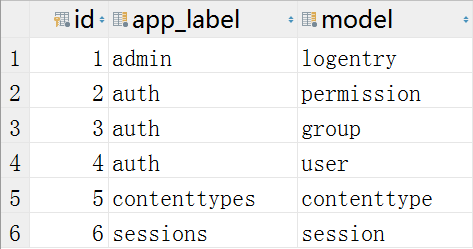Django包含了一个conenttype应用程序,记录了Django项目中安装的所有模型,为当前项目所有基于Django驱动的model提供了更高层次的抽象接口。
一、概述
ContentTypes应用程序的核心是 django.contrib.contenttypes.models.ContentType:
@python_2_unicode_compatible class ContentType(models.Model): app_label = models.CharField(max_length=100) model = models.CharField(_('python model class name'), max_length=100) objects = ContentTypeManager() class Meta: verbose_name = _('content type') verbose_name_plural = _('content types') db_table = 'django_content_type' unique_together = (('app_label', 'model'),) def __str__(self): return self.name
当我们不创建任何model的情况下就迁移数据库,就会发现在数据表中有名为django_content_type的表

二、安装ContentTypes框架
默认会在setting.py的INSTALL_APP中,如果不小心删除,可通过以下命令生成:
django-admin startprojectINSTALLED_APPS django.contrib.contenttypes'INSTALLED_APPS
三、ContentType模型
每个实例ContentType都有两个字段,它们唯一地描述了已安装的模型:
app_label:模型所属的应用程序名
model:模型类的名称
name:人类可读的内容类型名称,这取自verbose_name模型的属性
四、ContentType的应用
这里提供一个场景,比如网上商城,会有各种各样的优惠券,比如通用优惠券,在数据库中,我们通过外键将优惠券和不同品类的商品表关联起来。
id name 学位课程 专题课程 1 通用优惠券 null null 2 JavaEE限时免费 1 null 3 人工智能优惠券 null 1 4 Python全栈优惠券 2 null 5 Flask源码解读 null 3
这样做的弊端就是:
1. 随着课程的不断增加, 优惠券表中 字段会不断的增加
2. 对于每一个优惠券字段,不相关的都为null,消耗空间资源
通过使用ContentTypes应用中提供的特殊字段GeniricForeignKey.我们可以很好的解决这个问题
django_content_type:
id app_label model
1 admin logentry
2 auth permission
3 auth group
4 auth user
5 contenttypes contenttype
6 sessions session
7 course academiccourse
8 course specialcourse
9 course coupon
1. 在优惠券中定义一个ForerignKey字段,
并关联到django_content_type表。
通常这个字段命名为“content_type”
2. 在model中定义PositiveIntegerField字段
用来存储关联表中的主键
通常这个字段名为object_id
3. 在model中定义GenericForeignKey字段
传入上述两个字段名
class Coupon(models.Model): """ 优惠券 """ #优惠券名 name = models.CharField(max_length=32) #指向contenttype content_type = models.ForeignKey(to=ContentType) #关联表中的字段 object_id = models.PositiveIntegerField() content_object=GenericForeignKey("content_type","object_id")
创建记录和查询
1. 创建优惠券
django = models.AcademicCourse.objects.filter(name="Django开发").first()
coupon = models.Coupon.objects.create(name="Django免费体验",content_object=django)
coupon = models.Coupon.objects.create(name="JavaEE减2000",content_type_id=9,object_id=1)
2.查询优惠券(id=1)绑定了哪些商品
首先查出id=1的优惠券
coupon_obj = models.Coupon.objects.filter(id = 1).first()
coupon_obj.content_type_id #取关联django_content_type表的id
coupon_obj.content_type #点出来的是对象
coupon_obj.object_id #取关联对象的id
coupon_obj.content_object #取出对应的model对象
3.查询django开发的所有优惠券
一种是
models.Coupon.objects.filter(object_id = 2,content_type_id=9).all()
第二种是
反向查询,需要在每个商品表中添加
coupons = GenericRelation(to='Coupon')
python_obj = models.SpecialCourse.objects.filter(id = 2).first()
python_obj.coupon.all()